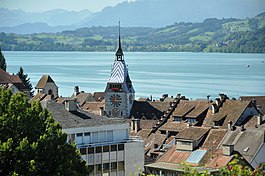Zug
| Zug | ||
|---|---|---|

View over Lake Zug with the old town of Zug and the Zytturm
|
||
|
||
| Coordinates: 47°10′N 8°31′E / 47.167°N 8.517°ECoordinates: 47°10′N 8°31′E / 47.167°N 8.517°E | ||
| Country | Switzerland | |
| Canton | Zug | |
| District | n.a. | |
| Government | ||
| • Executive |
Stadtrat with 5 members |
|
| • Mayor |
Stadtpräsident (list) Dolfi Müller SPS/PSS (as of December 2015, since 2007) |
|
| • Parliament |
Grosser Gemeinderat with 40 members , instaured 1963) |
|
| Area | ||
| • Total | 21.61 km2 (8.34 sq mi) | |
| Elevation (Landsgemeindeplatz) | 425 m (1,394 ft) | |
| Highest elevation (Zugerberg) | 1,039 m (3,409 ft) | |
| Lowest elevation (Sumpf (Dorfbach)) | 415 m (1,362 ft) | |
| Population (Dec 2015) | ||
| • Total | 29,256 | |
| • Density | 1,400/km2 (3,500/sq mi) | |
| Demonym(s) | German: Zuger/Zugerin | |
| Postal code | 6300 | |
| SFOS number | 1711 | |
| Surrounded by | Cham, Baar, Walchwil, Steinhausen | |
| Twin towns | Fürstenfeld (Austria) | |
| Website |
www SFSO statistics |
|
Zug (German: Zug, [tsuːɡ]; French: Zoug; Italian: Zugo; Romansh: Zug; Neo-Latin Tugium), is an affluent municipality and town in Switzerland. The name Zug originates from fishing vocabulary; in the Middle Ages it referred to the right to pull up fishing nets and hence to the right to fish.
The town of Zug is located in the canton of Zug and is the canton's capital. As of 31 December 2015 it had a total population of 29,256 inhabitants.
The official language of Zug is (the Swiss variety of Standard) German, but the main spoken language is the local variant of the Alemannic Swiss German dialect.
The oldest human traces date back to the time of around 14,000 BC. There have been Paleolithic finds on the north bank of Lake Zug, which come from nomadic hunters and gatherers. Archaeologists have also been able to prove the existence of over forty lake-shore settlements (pile dwellings), on the shores of Lake Zug, from the epoch of the first settled farmers in the Neolithic period (5,500-2,200 BC). The peak in these lake-shore village settlements was in the period between 3800 and 2450 BC. For the same epoch, the first pre-alpine land use has been proven in Menzingen and in the Ägeri valley. The well-known, historically-researched and interesting lake-shore village, ‘Sumpf’ (the swamp), dated from the late Bronze Age (up until 850 BC). These rich finds result in a quite differentiated picture of life in former times, attractively represented in the Zug Museum for Prehistory. In addition, many traces from the Iron Age (850-50 BC) and the Roman and Celtic-Roman time (from 50 BC) have been discovered.
...
Wikipedia



